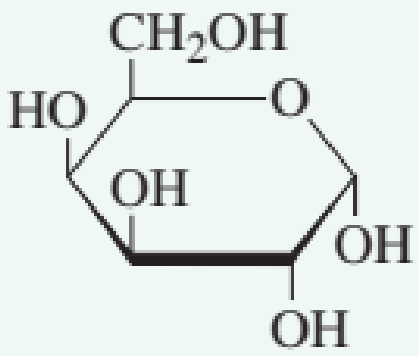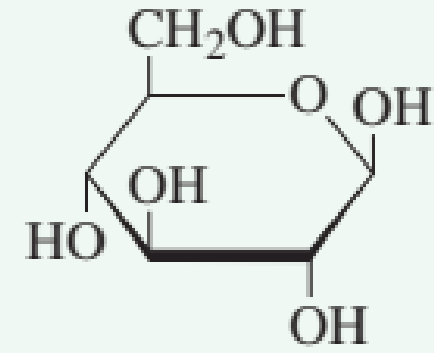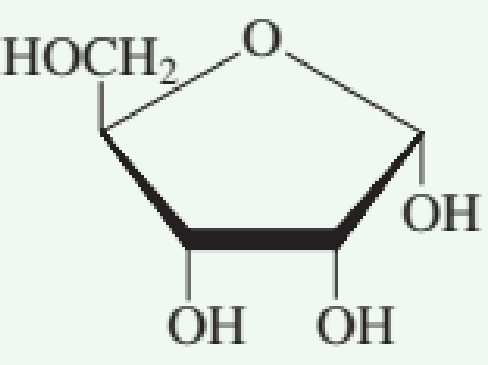
EBK GENERAL, ORGANIC, AND BIOLOGICAL CH
7th Edition
ISBN: 8220100853180
Author: STOKER
Publisher: CENGAGE L
expand_more
expand_more
format_list_bulleted
Concept explainers
Textbook Question
Chapter 18.10, Problem 2QQ
Which of the following structures represents a β-monosaccharide?



- a. no correct response
Expert Solution & Answer
Trending nowThis is a popular solution!

Students have asked these similar questions
An electrode process takes place at a metal-solution interface. Indicate the current condition that must be met for Faradaic rectification to occur.
At a metal-solution interface, an electron is exchanged, and the symmetry factor beta < 0.5 is found in the Butler-Volmer equation. What does this indicate?
Topic: Photochemistry and Photophysics of Supramolecules
Chapter 18 Solutions
EBK GENERAL, ORGANIC, AND BIOLOGICAL CH
Ch. 18.1 - In terms of mass percent, which of the following...Ch. 18.1 - Which of the following is the most abundant type...Ch. 18.2 - Which of the following statements concerning the...Ch. 18.2 - Prob. 2QQCh. 18.3 - Prob. 1QQCh. 18.3 - Prob. 2QQCh. 18.3 - Which of the following is not a possible value for...Ch. 18.3 - The complete hydrolysis of a polysaccharide...Ch. 18.4 - Prob. 1QQCh. 18.4 - Prob. 2QQ
Ch. 18.4 - Prob. 3QQCh. 18.4 - Prob. 4QQCh. 18.5 - Prob. 1QQCh. 18.5 - Prob. 2QQCh. 18.6 - Prob. 1QQCh. 18.6 - Which of the following Fischer projection formulas...Ch. 18.6 - Prob. 3QQCh. 18.6 - Prob. 4QQCh. 18.7 - Prob. 1QQCh. 18.7 - Prob. 2QQCh. 18.8 - Prob. 1QQCh. 18.8 - Which of the following statements about...Ch. 18.8 - The smallest monosaccharides that can exist are a....Ch. 18.9 - Prob. 1QQCh. 18.9 - Prob. 2QQCh. 18.9 - Prob. 3QQCh. 18.9 - In which of the following pairs of monosaccharides...Ch. 18.9 - In which of the following pairs of monosaccharides...Ch. 18.10 - Prob. 1QQCh. 18.10 - Which of the following structures represents a...Ch. 18.10 - Prob. 3QQCh. 18.10 - Prob. 4QQCh. 18.10 - Prob. 5QQCh. 18.11 - Prob. 1QQCh. 18.11 - Which of the following is the correct Haworth...Ch. 18.12 - Prob. 1QQCh. 18.12 - Prob. 2QQCh. 18.12 - Prob. 3QQCh. 18.12 - Prob. 4QQCh. 18.12 - Prob. 5QQCh. 18.13 - Which of the following disaccharides contains...Ch. 18.13 - Which of the following disaccharides will produce...Ch. 18.13 - In which of the following disaccharides is the...Ch. 18.13 - In which of the following pairs of disaccharides...Ch. 18.13 - Which of the following disaccharides is not a...Ch. 18.13 - The terms milk sugar and table sugar apply,...Ch. 18.14 - Prob. 1QQCh. 18.14 - Prob. 2QQCh. 18.15 - Which of the following statements about...Ch. 18.15 - Prob. 2QQCh. 18.16 - Prob. 1QQCh. 18.16 - Which of the following storage polysaccharides is...Ch. 18.16 - Prob. 3QQCh. 18.16 - Which of the following statements about storage...Ch. 18.17 - Prob. 1QQCh. 18.17 - Which of the following statements about cellulose...Ch. 18.17 - Chitin is a polysaccharide in which the...Ch. 18.18 - Which of the following statements about the...Ch. 18.18 - Prob. 2QQCh. 18.19 - Which of the following is not classified as a...Ch. 18.19 - Prob. 2QQCh. 18.20 - Prob. 1QQCh. 18.20 - Which of the following is not a biochemical...Ch. 18 - Prob. 18.1EPCh. 18 - Prob. 18.2EPCh. 18 - Prob. 18.3EPCh. 18 - Prob. 18.4EPCh. 18 - Prob. 18.5EPCh. 18 - Prob. 18.6EPCh. 18 - Prob. 18.7EPCh. 18 - Prob. 18.8EPCh. 18 - Prob. 18.9EPCh. 18 - Prob. 18.10EPCh. 18 - Prob. 18.11EPCh. 18 - Prob. 18.12EPCh. 18 - Prob. 18.13EPCh. 18 - Prob. 18.14EPCh. 18 - Prob. 18.15EPCh. 18 - Prob. 18.16EPCh. 18 - Prob. 18.17EPCh. 18 - Prob. 18.18EPCh. 18 - Prob. 18.19EPCh. 18 - Prob. 18.20EPCh. 18 - Prob. 18.21EPCh. 18 - Prob. 18.22EPCh. 18 - Prob. 18.23EPCh. 18 - Prob. 18.24EPCh. 18 - Prob. 18.25EPCh. 18 - Prob. 18.26EPCh. 18 - Prob. 18.27EPCh. 18 - Prob. 18.28EPCh. 18 - Prob. 18.29EPCh. 18 - Prob. 18.30EPCh. 18 - Prob. 18.31EPCh. 18 - Prob. 18.32EPCh. 18 - Prob. 18.33EPCh. 18 - Prob. 18.34EPCh. 18 - Draw the Fischer projection formula for each of...Ch. 18 - Prob. 18.36EPCh. 18 - Prob. 18.37EPCh. 18 - Prob. 18.38EPCh. 18 - Prob. 18.39EPCh. 18 - Prob. 18.40EPCh. 18 - Prob. 18.41EPCh. 18 - Prob. 18.42EPCh. 18 - Prob. 18.43EPCh. 18 - Prob. 18.44EPCh. 18 - Prob. 18.45EPCh. 18 - Prob. 18.46EPCh. 18 - Prob. 18.47EPCh. 18 - Prob. 18.48EPCh. 18 - Prob. 18.49EPCh. 18 - Prob. 18.50EPCh. 18 - Prob. 18.51EPCh. 18 - Prob. 18.52EPCh. 18 - Prob. 18.53EPCh. 18 - Prob. 18.54EPCh. 18 - Prob. 18.55EPCh. 18 - Prob. 18.56EPCh. 18 - Prob. 18.57EPCh. 18 - Prob. 18.58EPCh. 18 - Prob. 18.59EPCh. 18 - Prob. 18.60EPCh. 18 - Prob. 18.61EPCh. 18 - Prob. 18.62EPCh. 18 - Prob. 18.63EPCh. 18 - Prob. 18.64EPCh. 18 - Prob. 18.65EPCh. 18 - Prob. 18.66EPCh. 18 - Prob. 18.67EPCh. 18 - Prob. 18.68EPCh. 18 - Prob. 18.69EPCh. 18 - Prob. 18.70EPCh. 18 - Prob. 18.71EPCh. 18 - Prob. 18.72EPCh. 18 - Prob. 18.73EPCh. 18 - Prob. 18.74EPCh. 18 - Prob. 18.75EPCh. 18 - Prob. 18.76EPCh. 18 - Prob. 18.77EPCh. 18 - Prob. 18.78EPCh. 18 - Prob. 18.79EPCh. 18 - Prob. 18.80EPCh. 18 - Prob. 18.81EPCh. 18 - Prob. 18.82EPCh. 18 - Prob. 18.83EPCh. 18 - Prob. 18.84EPCh. 18 - Prob. 18.85EPCh. 18 - Prob. 18.86EPCh. 18 - Prob. 18.87EPCh. 18 - Prob. 18.88EPCh. 18 - Prob. 18.89EPCh. 18 - Prob. 18.90EPCh. 18 - Prob. 18.91EPCh. 18 - Prob. 18.92EPCh. 18 - Prob. 18.93EPCh. 18 - Prob. 18.94EPCh. 18 - Prob. 18.95EPCh. 18 - Prob. 18.96EPCh. 18 - Prob. 18.97EPCh. 18 - Prob. 18.98EPCh. 18 - Prob. 18.99EPCh. 18 - Prob. 18.100EPCh. 18 - Prob. 18.101EPCh. 18 - Prob. 18.102EPCh. 18 - Prob. 18.103EPCh. 18 - Prob. 18.104EPCh. 18 - For each structure in Problem 18-103, identify the...Ch. 18 - For each structure in Problem 18-104, identify the...Ch. 18 - Prob. 18.107EPCh. 18 - Prob. 18.108EPCh. 18 - Prob. 18.109EPCh. 18 - Prob. 18.110EPCh. 18 - Prob. 18.111EPCh. 18 - Prob. 18.112EPCh. 18 - Prob. 18.113EPCh. 18 - Prob. 18.114EPCh. 18 - Prob. 18.115EPCh. 18 - Prob. 18.116EPCh. 18 - Prob. 18.117EPCh. 18 - Prob. 18.118EPCh. 18 - Prob. 18.119EPCh. 18 - Prob. 18.120EPCh. 18 - Prob. 18.121EPCh. 18 - Prob. 18.122EPCh. 18 - Prob. 18.123EPCh. 18 - Prob. 18.124EPCh. 18 - Prob. 18.125EPCh. 18 - Prob. 18.126EPCh. 18 - Prob. 18.127EPCh. 18 - Prob. 18.128EPCh. 18 - Prob. 18.129EPCh. 18 - Prob. 18.130EPCh. 18 - Prob. 18.131EPCh. 18 - Prob. 18.132EPCh. 18 - Prob. 18.133EPCh. 18 - Prob. 18.134EPCh. 18 - Prob. 18.135EPCh. 18 - Prob. 18.136EPCh. 18 - Prob. 18.137EPCh. 18 - Prob. 18.138EPCh. 18 - Prob. 18.139EPCh. 18 - Prob. 18.140EPCh. 18 - Prob. 18.141EPCh. 18 - Prob. 18.142EPCh. 18 - Prob. 18.143EPCh. 18 - Prob. 18.144EPCh. 18 - Prob. 18.145EPCh. 18 - Prob. 18.146EPCh. 18 - Prob. 18.147EPCh. 18 - Prob. 18.148EPCh. 18 - Prob. 18.149EPCh. 18 - Prob. 18.150EPCh. 18 - Prob. 18.151EPCh. 18 - Prob. 18.152EPCh. 18 - Prob. 18.153EPCh. 18 - Prob. 18.154EPCh. 18 - Prob. 18.155EPCh. 18 - Prob. 18.156EPCh. 18 - Prob. 18.157EPCh. 18 - Prob. 18.158EPCh. 18 - Prob. 18.159EPCh. 18 - Prob. 18.160EPCh. 18 - Prob. 18.161EPCh. 18 - Prob. 18.162EPCh. 18 - Prob. 18.163EPCh. 18 - Prob. 18.164EPCh. 18 - Prob. 18.165EPCh. 18 - Prob. 18.166EPCh. 18 - Prob. 18.167EPCh. 18 - Prob. 18.168EPCh. 18 - Prob. 18.169EPCh. 18 - Prob. 18.170EPCh. 18 - Describe the general features of the cell...Ch. 18 - Prob. 18.172EP
Knowledge Booster
Learn more about
Need a deep-dive on the concept behind this application? Look no further. Learn more about this topic, biology and related others by exploring similar questions and additional content below.Similar questions
- When two solutions, one of 0.1 M KCl (I) and the other of 0.1 M MCl (II), are brought into contact by a membrane. The cation M cannot cross the membrane. At equilibrium, x moles of K+ will have passed from solution (I) to (II). To maintain the neutrality of the two solutions, x moles of Cl- will also have to pass from I to II. Explain this equality: (0.1 - x)/x = (0.1 + x)/(0.1 - x)arrow_forwardCalculate the variation in the potential of the Pt/MnO4-, Mn2+ pair with pH, indicating the value of the standard potential. Data: E0 = 1.12.arrow_forwardGiven the cell: Pt l H2(g) l dis X:KCl (sat) l Hg2Cl2(s) l Hg l Pt. Calculate the emf of the cell as a function of pH.arrow_forward
- The decimolar calomel electrode has a potential of 0.3335 V at 25°C compared to the standard hydrogen electrode. If the standard reduction potential of Hg22+ is 0.7973 V and the solubility product of Hg2Cl2 is 1.2x 10-18, find the activity of the chlorine ion at this electrode.Data: R = 8.314 J K-1 mol-1, F = 96485 C mol-1, T = 298.15 K.arrow_forward2. Add the following group of numbers using the correct number of significant figures for the answer. Show work to earn full credit such as rounding off the answer to the correct number of significant figures. Replace the question marks with the calculated answers or write the calculated answers near the question marks. 10916.345 37.40832 5.4043 3.94 + 0.0426 ? (7 significant figures)arrow_forwardThe emf at 25°C of the cell: Pt l H2(g) l dis X:KCl (sat) l Hg2Cl2(s) l Hg l Pt was 612 mV. When solution X was replaced by normal phosphate buffer solution with a pH of 6.86, the emf was 741 mV. Calculate the pH of solution X.arrow_forward
- Indicate how to calculate the potential E of the reaction Hg2Cl2(s) + 2e ⇄ 2Hg + 2Cl- as a function of the concentration of Cl- ions. Data: the solubility product of Hg2Cl2.arrow_forwardHow can Beer’s Law be used to determine the concentration in a selected food sample. Provide an in-depth discussion and examples of this.arrow_forwardb) H3C- H3C Me CH 3 I HN Me H+arrow_forward
arrow_back_ios
SEE MORE QUESTIONS
arrow_forward_ios
Recommended textbooks for you
 General, Organic, and Biological ChemistryChemistryISBN:9781285853918Author:H. Stephen StokerPublisher:Cengage Learning
General, Organic, and Biological ChemistryChemistryISBN:9781285853918Author:H. Stephen StokerPublisher:Cengage Learning Organic And Biological ChemistryChemistryISBN:9781305081079Author:STOKER, H. Stephen (howard Stephen)Publisher:Cengage Learning,
Organic And Biological ChemistryChemistryISBN:9781305081079Author:STOKER, H. Stephen (howard Stephen)Publisher:Cengage Learning,

General, Organic, and Biological Chemistry
Chemistry
ISBN:9781285853918
Author:H. Stephen Stoker
Publisher:Cengage Learning

Organic And Biological Chemistry
Chemistry
ISBN:9781305081079
Author:STOKER, H. Stephen (howard Stephen)
Publisher:Cengage Learning,
Nucleic acids - DNA and RNA structure; Author: MEDSimplified;https://www.youtube.com/watch?v=0lZRAShqft0;License: Standard YouTube License, CC-BY